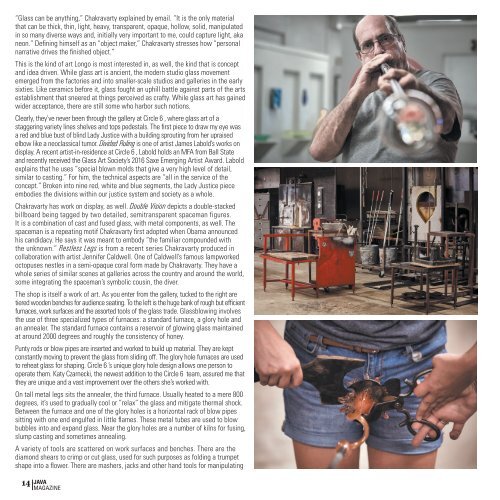You also want an ePaper? Increase the reach of your titles
YUMPU automatically turns print PDFs into web optimized ePapers that Google loves.
“Glass can be anything,” Chakravarty explained by email. “It is the only material<br />
that can be thick, thin, light, heavy, transparent, opaque, hollow, solid, manipulated<br />
in so many diverse ways and, initially very important to me, could capture light, aka<br />
neon.” Defining himself as an “object maker,” Chakravarty stresses how “personal<br />
narrative drives the finished object.”<br />
This is the kind of art Longo is most interested in, as well, the kind that is concept<br />
and idea driven. While glass art is ancient, the modern studio glass movement<br />
emerged from the factories and into smaller-scale studios and galleries in the early<br />
sixties. Like ceramics before it, glass fought an uphill battle against parts of the arts<br />
establishment that sneered at things perceived as crafty. While glass art has gained<br />
wider acceptance, there are still some who harbor such notions.<br />
Clearly, they’ve never been through the gallery at Circle 6 , where glass art of a<br />
staggering variety lines shelves and tops pedestals. The first piece to draw my eye was<br />
a red and blue bust of blind Lady Justice with a building sprouting from her upraised<br />
elbow like a neoclassical tumor. Divided Ruling is one of artist James Labold’s works on<br />
display. A recent artist-in-residence at Circle 6 , Labold holds an MFA from Ball State<br />
and recently received the Glass Art Society’s 2016 Saxe Emerging Artist Award. Labold<br />
explains that he uses “special blown molds that give a very high level of detail,<br />
similar to casting.” For him, the technical aspects are “all in the service of the<br />
concept.” Broken into nine red, white and blue segments, the Lady Justice piece<br />
embodies the divisions within our justice system and society as a whole.<br />
Chakravarty has work on display, as well. Double Vision depicts a double-stacked<br />
billboard being tagged by two detailed, semitransparent spaceman figures.<br />
It is a combination of cast and fused glass, with metal components, as well. The<br />
spaceman is a repeating motif Chakravarty first adopted when Obama announced<br />
his candidacy. He says it was meant to embody “the familiar compounded with<br />
the unknown.” Restless Legs is from a recent series Chakravarty produced in<br />
collaboration with artist Jennifer Caldwell. One of Caldwell’s famous lampworked<br />
octopuses nestles in a semi-opaque coral form made by Chakravarty. They have a<br />
whole series of similar scenes at galleries across the country and around the world,<br />
some integrating the spaceman’s symbolic cousin, the diver.<br />
The shop is itself a work of art. As you enter from the gallery, tucked to the right are<br />
tiered wooden benches for audience seating. To the left is the huge bank of rough but efficient<br />
furnaces, work surfaces and the assorted tools of the glass trade. Glassblowing involves<br />
the use of three specialized types of furnaces: a standard furnace, a glory hole and<br />
an annealer. The standard furnace contains a reservoir of glowing glass maintained<br />
at around 2000 degrees and roughly the consistency of honey.<br />
Punty rods or blow pipes are inserted and worked to build up material. They are kept<br />
constantly moving to prevent the glass from sliding off. The glory hole furnaces are used<br />
to reheat glass for shaping. Circle 6 ’s unique glory hole design allows one person to<br />
operate them. Katy Czarnecki, the newest addition to the Circle 6 team, assured me that<br />
they are unique and a vast improvement over the others she’s worked with.<br />
On tall metal legs sits the annealer, the third furnace. Usually heated to a mere 800<br />
degrees, it’s used to gradually cool or “relax” the glass and mitigate thermal shock.<br />
Between the furnace and one of the glory holes is a horizontal rack of blow pipes<br />
sitting with one end engulfed in little flames. These metal tubes are used to blow<br />
bubbles into and expand glass. Near the glory holes are a number of kilns for fusing,<br />
slump casting and sometimes annealing.<br />
A variety of tools are scattered on work surfaces and benches. There are the<br />
diamond shears to crimp or cut glass, used for such purposes as folding a trumpet<br />
shape into a flower. There are mashers, jacks and other hand tools for manipulating<br />
14 JAVA<br />
MAGAZINE


















